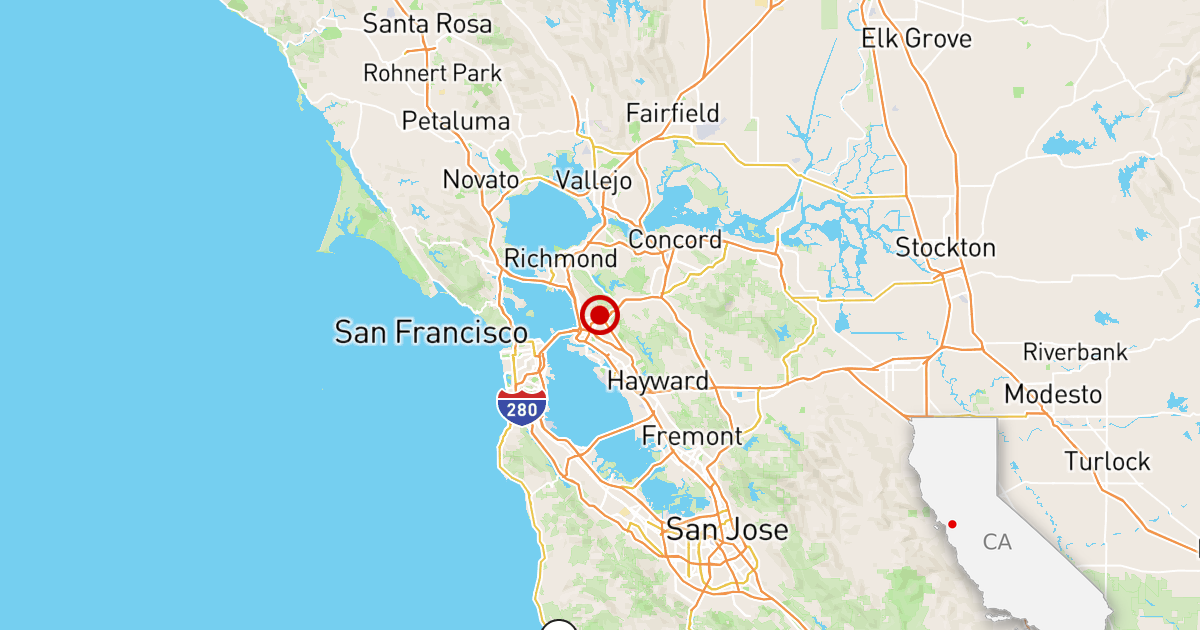
This is read by an automated voice. Please report any issues or inconsistencies here.
An earthquake strong enough to awaken people across the region rattled the San Francisco Bay Area early Monday morning.
The earthquake, estimated at a magnitude 4.3, occurred at 2:56 a.m. and was centered in Berkeley. A preliminary estimate suggested the earthquake was centered around the corner of Dwight Way and Piedmont Avenue, just a few blocks from the UC Berkeley campus.
Monday’s earthquake was the most powerful to hit the Bay Area in three years. A magnitude 5.1 earthquake ruptured underneath the sparsely populated hills east of San José, near Mount Hamilton, on Oct. 25, 2022.
“Light” shaking, as defined by the Modified Mercalli Intensity Scale, was felt Monday across Berkeley, Oakland and San Francisco, according to the U.S. Geological Survey. Other areas that saw “light” shaking include Albany, Alameda, San Leandro, Piedmont, Orinda, Lafayette, Walnut Creek and Richmond.
“Light” shaking can disturb dishes and windows, visibly rock standing motor cars and feel like a heavy truck has struck a building.
There were no immediate reports of major damage. A display window at a butcher shop shattered in Berkeley, KTVU-TV reported, and a listener in the Oakland Hills told KCBS radio that his dishes spilled across the floor. KGO-TV broadcast images of plastic bottles fallen from store shelves in Oakland’s Montclair neighborhood.
A magnitude 2.6 aftershock struck at 8:01 a.m. near Claremont and Ashby avenues, close to the Claremont Resort and Club.
There is a 4% chance that there will be another magnitude 4 or greater earthquake in the next week, according to the U.S. Geological Survey. There is also a less than 1% chance of an aftershock of an earthquake of magnitude 5 or greater over the next week.
The epicenter of the earthquake was located near the Hayward fault — one of the most feared in the San Francisco Bay Area. The fault runs for 74 miles through the East Bay and into San José.
The Hayward fault’s biggest earthquake in modern history occurred in 1868, when a magnitude 7 earthquake ruptured probably between Fremont’s Warm Springs neighborhood all the way to Berkeley, according to the California Geological Survey.
California
A report by the U.S. Geological Survey estimates that at least 800 people could be killed and 18,000 more injured in a hypothetical magnitude 7 earthquake that ruptures 52 miles of the Hayward fault between Fremont and San Pablo Bay. As many as 2,500 people could need to be rescued from collapsed buildings, and 22,000 people could be trapped in elevators.
Monday’s earthquake was felt as far away as Santa Rosa to Santa Cruz.
The earthquake activated the MyShake earthquake early warning app, powered by the U.S. Geological Survey’s ShakeAlert system.
Some people said they felt the earthquake at around the same time as the early warning app sounded on their phone.
California
California has suffered some destructive earthquakes in the last few decades but much bigger quakes are possible. These maps show some scenarios.
In Alameda, Laura Sonido woke up to the earthquake, feeling shaking initially for about five seconds, followed by another strong jolt and a few more seconds of shaking.
“It was strong enough to where I could hear my windows rattling,” Sonido said. “Nothing broke in the house, but the mirrored bathroom cabinets swung open. Thankfully, nothing spilled out.”
Did you feel this earthquake? Consider reporting what you felt to the USGS.
Find out what to do before, and during, an earthquake near you by signing up for our Unshaken newsletter, which breaks down emergency preparedness into bite-sized steps over six weeks. Learn more about earthquake kits, which apps you need, Lucy Jones’ most important advice and more at latimes.com/Unshaken.
Sign up for Essential California
The most important California stories and recommendations in your inbox every morning.
You may occasionally receive promotional content from the Los Angeles Times.
Follow Us
Rong-Gong Lin II is a reporter for the Los Angeles Times based in San Francisco who specializes in covering statewide earthquake safety issues and other natural disasters, public health and extreme weather. The Bay Area native is a graduate of UC Berkeley and started at The Times in 2004.
California
California
California
California
Altadena fire survivors face uncertainty rebuilding. We talk with Greenline Housing, a group helping Black and Latino families buy lots to preserve the community’s character.
After a jail fight, an inmate defies norms and becomes an expert in the jail’s computer system. A smuggled phone leads to a shocking cover-up.
Police hunted a serial killer preying on women in 1970s Los Angeles. Richard Winton and Madison McGhee discuss the case’s grim history and recent developments.
California
California
California
California
Subscribe for unlimited access
Site Map
Follow Us
MORE FROM THE L.A. TIMES
